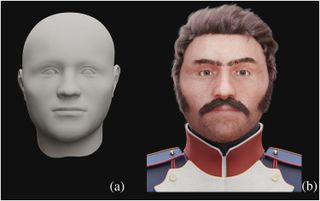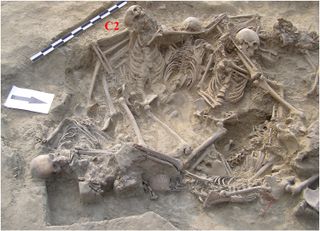This French Soldier Got Slashed in Russia in 1812. Now, We Know What He Looked Like.

In a battle against Russia more than 200 years ago, a French soldier in Napoleon's Grande Armée was slashed in the face with a saber. He died a few weeks later, his body laid to rest in a mass burial pit in what was then Königsberg, East Prussia.
Now, scientists have uncovered the soldier's remains, and with cutting-edge technology, they have created a digital reconstruction of his face, according to a new study.
"This wounded soldier was on the way to recovery when he died, possibly from a comorbid [accompanying] cause, [as] epidemic outbreaks of typhus and trench fever occurred in Königsberg in late 1812 and early 1813," study first author Dany Coutinho Nogueira, a doctoral student of biological anthropology at the Paris Sciences et Lettres (PSL) Research University, told Live Science in an email. [Photos: Archaeologists Excavate Battlefield from Napoleonic Wars]
The soldier's life took a turn when Napoleon Bonaparte invaded Russia in 1812. Despite Napoleon's success elsewhere, "this military campaign was a disaster, and the Grande Armée was decimated," with up to 500,000 French dead, the researchers wrote in the study.
The campaign ended with the Battle of Berezina in November 1812. But the majority of the French soldiers didn't die in battle. Instead, the frigid Russian winter, infectious diseases and starvation killed multitudes, leading to mass burials, the researchers said. Some of these graves are in Königsberg, the capital city of Eastern Prussia, which is known today as Kaliningrad, Russia.
In the summer of 2006, a group of Russian researchers excavated parts of Kaliningrad. Among their findings were 12 mass graves that together contained at least 600 victims, with the individuals' military buttons still lying next to their remains, as Buzzfeed initially reported. One of these pits held 26 people, including the man who was slashed with a saber.

Mystery man
Not much is known about the man, but he was likely between 24 and 27 years old when he died, meaning he was born between 1785 and 1788, before the French Revolution began, the researchers found.
Sign up for the Live Science daily newsletter now
Get the world’s most fascinating discoveries delivered straight to your inbox.
An analysis of his skull and jaw revealed that the soldier was likely injured by a heavy cavalry saber in a fight against Russian troops. However, "this wound was severe but not immediately lethal," the researchers wrote in the study, as they found evidence that his bones had healed slightly before he died, likely six weeks to three months after the slashing.
In fact, it was the soldier's severe wounds and missing bone that drew the researchers to him. The team wanted to reconstruct the face of a soldier with "severe facial trauma," Coutinho Nogueira said. To do so, the researchers used two techniques: mirror imaging (modeling missing bones on those from the opposite side of the skull and jaw), when possible, and looking at a reference individual as a model otherwise. In this case, the model was a 22-year-old French man.

By using a craniofacial CT-scan of the reference individual, the researchers could give the soldier "virtual bone transplants," the researchers wrote in the study.
The study didn't involve a genetic component, so "we interpreted eye and hair color using the most common phenotypes represented in France: brown eyes and brown hair," Coutinho Nogueira said. "But this young man could also have had blue eyes and blond hair."
Even though this facial reconstruction isn't a perfect match for the original individual (researchers call their work an approximation), it still allows people to "focus our empathy on a face," Coutinho Nogueira said. "It is that of a young man who suffered a lot, died far from his family and never returned home." [25 Grisly Archaeological Discoveries]
The soldier's fate is emblematic of hundreds of thousands of young soldiers of the Grande Armée and other European armies at that time, Coutinho Nogueira said. And some of them, including this man, received care. For instance, Baron Dominique Jean Larrey, a military surgeon who worked during the Russian Campaign (also called the French invasion of Russia), helped rescue wounded people from the battlefield and performed surgeries when possible.
"[Larrey] describes in his memoirs a similar case and the recommended procedure for treating this type of injury, and it seems to correspond to what is observed on this individual," Coutinho Nogueira said. "The fact that the soldier survived for about two months, despite this injury, also shows that care, treatment and attention to the wounded continued during the retreat despite the terrible conditions."
The study was published online in December 2018 in the International Journal of Osteoarchaeology.
- 19 of the World's Oldest Photos Reveal a Rare Side of History
- Photos: Mass Graves Hold 17th-Century Prisoners of War
- Photos: A 400-Year-Old War Grave Revealed
Originally published on Live Science.

Laura is the archaeology and Life's Little Mysteries editor at Live Science. She also reports on general science, including paleontology. Her work has appeared in The New York Times, Scholastic, Popular Science and Spectrum, a site on autism research. She has won multiple awards from the Society of Professional Journalists and the Washington Newspaper Publishers Association for her reporting at a weekly newspaper near Seattle. Laura holds a bachelor's degree in English literature and psychology from Washington University in St. Louis and a master's degree in science writing from NYU.
